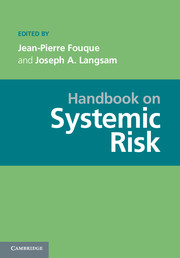Book contents
- Frontmatter
- Contents
- Contributors
- Introduction
- PART I DATA: THE PREREQUISITE FOR MANAGING SYSTEMIC RISK
- PART II STATISTICS AND SYSTEMIC RISK
- PART III MEASURING AND REGULATING SYSTEMIC RISK
- PART IV NETWORKS
- PART V SYSTEMIC RISK ANDMATHEMATICAL FINANCE
- 14 Firms, Banks and Households
- 15 An Agent-Based Computational Model for Bank Formation and Interbank Networks
- 16 Diversification in Financial Networks may Increase Systemic Risk
- 17 Systemic Risk Illustrated
- 18 Financial Crisis and Contagion: A Dynamical Systems Approach
- PART VI COUNTERPARTY RISK AND SYSTEMIC RISK
- PART VII ALGORITHMIC TRADING
- PART VIII BEHAVIORAL FINANCE: THE PSYCHOLOGICAL DIMENSION OF SYSTEMIC RISK
- PART IX REGULATION
- PART X COMPUTATIONAL ISSUES AND REQUIREMENTS
- PART XI ACCOUNTING ISSUES
- References
14 - Firms, Banks and Households
from PART V - SYSTEMIC RISK ANDMATHEMATICAL FINANCE
Published online by Cambridge University Press: 05 June 2013
- Frontmatter
- Contents
- Contributors
- Introduction
- PART I DATA: THE PREREQUISITE FOR MANAGING SYSTEMIC RISK
- PART II STATISTICS AND SYSTEMIC RISK
- PART III MEASURING AND REGULATING SYSTEMIC RISK
- PART IV NETWORKS
- PART V SYSTEMIC RISK ANDMATHEMATICAL FINANCE
- 14 Firms, Banks and Households
- 15 An Agent-Based Computational Model for Bank Formation and Interbank Networks
- 16 Diversification in Financial Networks may Increase Systemic Risk
- 17 Systemic Risk Illustrated
- 18 Financial Crisis and Contagion: A Dynamical Systems Approach
- PART VI COUNTERPARTY RISK AND SYSTEMIC RISK
- PART VII ALGORITHMIC TRADING
- PART VIII BEHAVIORAL FINANCE: THE PSYCHOLOGICAL DIMENSION OF SYSTEMIC RISK
- PART IX REGULATION
- PART X COMPUTATIONAL ISSUES AND REQUIREMENTS
- PART XI ACCOUNTING ISSUES
- References
Summary
Abstract This chapter sets up and analyses a continuous-time equilibrium model with firms, households and a bank. The model allows us to study the inter-relation of production, consumption, levels of working, interest rates, debt, inflation and wage levels.
Introduction
As the contents of this volume testify, what constitutes systemic risk, and how this may be modeled and analyzed, is open to many different interpretations. In general terms, we are concerned with how financial markets affect the real economy; and with the possibility that many different assets might fall in value at the same time, with consequent loss of confidence and further losses to follow. One simple approach would be to treat the returns of a set of assets of interest as correlated time series; but such a view would only address correlation, without making any statements about causation. At the next level, we could investigate models where changes in the price of one asset may impact the price of other assets, establishing a causal route, but not giving much guidance on the form of such causation, nor on its origins; what is the chicken, what the egg? The key issues for modelling revolve around how shocks to the system occur, and how the components of the system respond to those shocks and to the responses of other components. It is the second of these issues which is the most problematic; a simple-minded imposition of some rules by which the components of the system respond together is liable to appear ad hoc, and may lead to inconsistencies and calibration issues not apparent at the outset. Our attempt to deal with this is to work within an equilibrium framework, where the principles by which prices form and evolve are at least well established, even if quite hard to analyse.
- Type
- Chapter
- Information
- Handbook on Systemic Risk , pp. 372 - 400Publisher: Cambridge University PressPrint publication year: 2013



